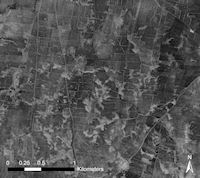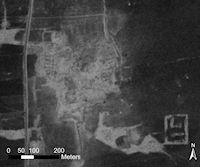
Figure 41: Stone clearance walls from southern Syria, showing patterns of Roman centuriation [CORONA atlas]

Figure 41: Stone clearance walls from southern Syria, showing patterns of Roman centuriation [CORONA atlas]
Throughout much of western Syria and Lebanon, remains of Roman and later field systems are visible in CORONA imagery, but many of these remarkable features have been lost as a result of modern land use. Among the most studied ancient fields in the world are the centuriated fields of the Roman period, generally appearing as near-perfect squares covering large parts of the landscape (e.g. Palet and Orengo 2011; Bescoby 2006). These plots were surveyed in newly conquered territories and granted to retiring military officers. In many parts of the Mediterranean basin, centuriated fields were preserved by their continued use as agricultural fields by small landholders. While fields might be subdivided and exchanged countless times over the centuries, the boundaries between different plots were often maintained, and frequently remain visible as stone clearance walls. Such features are especially common in rocky soils where agriculture required extensive clearance work in the past, sometimes resulting in the construction of very large stone boundary features. An excellent example of such features with remnants of the preserved Roman period boundaries evident can be seen in far southern Syria (Figure 41). Nearby, numerous archaeological sites possess remains of substantial stone architecture, much of which has never been systematically documented. Occasionally, even the plan of buildings can be resolved on CORONA imagery, as in this case of an unrecorded site near the field boundaries pictured above (Figure 42).

Figure 42: Remains of likely Roman/late Roman architecture in southern Syria [CORONA atlas]
In wetter environments of the Orontes Valley region, such features are rare, despite the intensive settlement in the area during the Roman and late Roman periods. However, in one area just south-east of Homs, the faint remnants of once extensive centuriated plots can be seen as crop marks below the modern field systems (Figure 43) (Casana, in press). In this case, the boundaries of ancient fields are preserved owing to differences in soil colour produced by cultivation of fields over many centuries. These features were originally noted as appearing on aerial photographs by van Liere (1958-9), but the CORONA imagery now available reveals the fields with great clarity and enables them to be mapped over a much larger area than has previously been possible.
In the uplands to the north, stone clearance walls can often be found, particularly in rocky soils of basalt outcrops. These marginal areas were only brought under cultivation during the peak phase of settlement in the region, during the Roman and late Roman periods, resulting in good preservation of field boundaries through the 1960s. Despite extensive settlement in these hills during this period, no trace of centuriation is visible, suggesting a different land use history from other areas to the south (Figure 44). Recent field investigations in the Orontes region have found that many of the ancient field boundaries have been destroyed in the past few years by newly expanded settlement and efforts to once again farm these marginal areas (Philip and Bradbury 2010).
© Internet Archaeology/Author(s)
University of York legal statements | Terms and Conditions
| File last updated: Fri Sept 21 2012